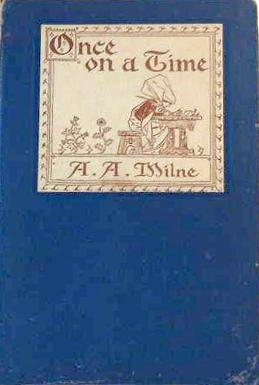Once on a Time facts for kids
Once On A Time is a fun fairy tale book written by the famous English author A. A. Milne. He is best known for creating Winnie-the-Pooh. This book was written in 1917.
Milne said this book was "odd" right from the start. It looks like a typical fairy tale. But it tells a story about a war between two kingdoms: Euralia and Barodia. It also shows the tricky political games happening in Euralia. These events happen while the king is away. Milne supposedly rewrote the story from an old historian named "Roger Scurvilegs."
Milne wanted his characters to feel real. They are not like the simple characters you often find in children's stories. For example, the princess is very capable, not helpless. The handsome prince is also quite proud and vain. The "bad guy" isn't completely evil. Even the good king isn't always good. This makes the story more interesting for older readers. Milne wrote this book partly for his wife. The character of Countess Belvane was inspired by her.
The Story of Once On A Time
A War Begins with Boots
The King of Barodia gets a special birthday gift: seven-league boots. These boots let him take giant steps. He loves to fly over the King of Euralia's castle during breakfast. This annoys the King of Euralia. Soon, small arguments grow into a big war.
Princess Hyacinth Takes Charge
While the King of Euralia is away fighting, his daughter, Princess Hyacinth, tries to rule. She is young but smart. She has to deal with the Countess Belvane. The Countess is the king's favorite. She has many tricky plans to gain power. Hyacinth must learn fast to protect her kingdom.
Meet the Characters
King Merriwig of Euralia
King Merriwig is the ruler of Euralia. He is a bit fat and usually jolly. Sometimes he can be pompous, meaning he acts a bit too proud. He is also easily tricked. But he can be very strong-willed when he needs to be. Once, he even outsmarted a fairy just by being stubborn!
Princess Hyacinth
Hyacinth is King Merriwig's daughter. She is much smarter and more practical than her father. At first, she finds it hard to rule the kingdom. She is new to all the political challenges. But she quickly learns and grows into a strong leader.
The King of Barodia
This king is loud, proud, and very arrogant. He loves his mustache more than anything. His pride is a big reason why the war starts.
Countess Belvane
The Countess Belvane is a complex character. She is beautiful, proud, and often dramatic. She loves to indulge in her emotions. She seems like the villain of the story. But her reasons for doing things are not simple. She is not just evil for evil's sake.
Lady Wiggs
Lady Wiggs is Princess Hyacinth's best friend. She is very helpful and often seems to be dreaming.
Lady Woggs
Lady Woggs works in the palace. She means well and tries to help. But she is not very bright and often makes mistakes.
Prince Udo of Araby
Prince Udo comes from a nearby kingdom. Princess Hyacinth asks him for help with Countess Belvane. But Prince Udo isn't very helpful. He suffers from a funny magical spell. Also, his personality makes him not very useful. He is quite full of himself.
Coronel
Coronel is Prince Udo's friend and companion. He is much more relaxed and likable than Prince Udo. He often balances out Udo's proud nature.
Roger Scurvilegs
Roger Scurvilegs is a famous historian from Euralia. He wrote a huge book called Euralia Past and Present. The person telling the story gives him credit for the facts. But the narrator also gently makes fun of him for being a bit stuffy and overly serious.
What the Book is About: Themes and Ideas
Milne's Thoughts on His Book
A. A. Milne himself found it hard to describe this book. In his introduction to the 1922 edition, he wrote about who the book was for. He said, "For whom, then, is the book intended? That is the trouble." He wondered if it was a children's book.
Milne compared it to other famous books like The Wind in the Willows and Alice's Adventures in Wonderland. These books are enjoyed by kids. But adults often enjoy them even more. He believed that a writer must first write a book for themselves. Only then can children truly like it.
A Story for Everyone
Milne boldly stated that Once On A Time is a story for grown-ups. But he also said it's hard to explain exactly what kind of book it is. He suggested that it doesn't need an explanation. You can read it and decide for yourself. He believed you will either enjoy it or you won't. It's "that sort of book." This means the book has layers that appeal to different ages. It's not just a simple fairy tale.
{{{name}}} at Project Gutenberg


